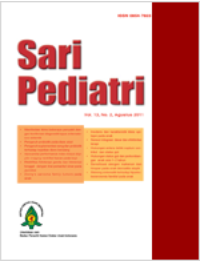Efektivitas Fototerapi Terhadap Penurunan Kadar Bilirubin Total pada Hiperbilirubinemia Neonatal di RSUP Sanglah
Sari
Latar belakang. Enampuluh persen bayi lahir normal berkembang menjadi kuning dalam satu minggu pertama kehidupan. Fototerapi merupakan salah satu tatalaksana mengurangi hiperbilirubinemia melalui proses fotoisomerisasi dan isomerisasi struktural.
Tujuan. Mengetahui jumlah penurunan kadar serum bilirubin total pada bayi hiperbilirubinemia usia gestasi ≥35 minggu setelah dilakukan fototerapi selama 24 jam, agar dapat memprediksi lama perawatan fototerapi di rumah sakit. Metode. Penelitian cohort dengan melibatkan 44 bayi hiperbilirubinemia usia kehamilan ≥35 minggu, melihat kadar bilirubin sebelum dan setelah dilakukan fototerapi. Analisis data dan statistik digunakan SPSS 22 dan uji t berpasangan dengan nilai p≤0,05 dan koefisien interval 95% dianggap signifikan.
Hasil. Rerata usia kuning 4,2±0,88 hari dengan rerata berat badan 2784±643 gram. Rerata kadar bilirubin sebelum dilakukan fototerapi 15,3±1,94 mg/dL, dan setelah dilakukan fototerapi 24 jam 12,8±1,88 mg/dL dengan p=0,001. Penurunan kadar bilirubin 2,5±0,8mg/dL dalam 24 jam (turun 16,3% dalam 24 jam). Komplikasi fototerapi yaitu hipertermi (2,3%) dan eritema (27,3%). Kesimpulan. Penurunan kadar bilirubin setelah dilakukan fototerapi selama 24 jam 2,5±0,8mg/dL (turun 16,3%).
Kata Kunci
Teks Lengkap:
PDFReferensi
Daftar pustaka
Health Technology Assestment. Tatalaksana ikterus neonatorum. HTA Indonesia. Unit pengkajian teknologi kesehatan direktorat jenderal pelayanan medik departemen kesehatan RI. Jakarta; HTA Indonesia;
Gomella TL. Hyperbilirubinemia indirect (unconjugated hyperbilirubinemia). Dalam: Management, procedure, on-call, disease and drug. Seventh edition. Lange; 2009.h.498-510.
Chime G, Egenede J, Arute J. Prevalence of Neonatal Jaundice on Central Hospital, Warri, Delta State, Nigeria. Int J Health Res 2011;4:123-6.
Hammerman C, Kaplan M. Recent developments in the management of neonatal hyperbilirubinemia. Neoreviews 2000;1:19-23.
Philip A. The rise an fall of exchange transfusion. Neoreviews 2000;4:169-74.
Ahmed NA, Hamdoon GW. A Prospective randomized controlled study of phototherapy using blue LED and conventional phototherapy in neonatal hyperbilirubinemia. Iraqi Postgrad Med J 2013;12:668-74.
Kappas A. A method for interdicting the development of severe jaundice in newborn by inhibiting the production of bilirubin. Pediatrics 2004;11:119-22.
Deorari A, Agarwal R. Unconjugated hyperbilirubinemia in newborns: current perspective. Indian Pediatrics 2002;39:30-42.
AAP. Management of hyperbilirubinemia in the newborn infant 35 or more weeks of gestation. Pediatrics. 2004;114:297-316.
Brandao D, Draque C, Sanudo A, Filho G, Almeida M. LED versus daylight phototherapy at low irradiance in newborns ≥ 35 weeks of gestation : randomized controlled trial. J Matern Fetal Neonatal Med 2015;28:1725-30.
Seidman DS, Moise J, Ergaz Z, Laor A, Vreeman H, Stevenson D, dkk. A prospective Randomized controlled study of phototherapy using blue and blue-green lightemitting devices, and conventional halogen-quartz phototherapy. J Perinatol 2003;23:123-7.
Martin C, Cloherry J. Neonatal hyperbilirubinemia. Dalam: Cloherty J, Eichenwald E, Stark A, penyunting. Manual of neonatal care. Edisi ke-5. USA. Lippincot Wiliams & Walkins;2004.h.185-221.
Xiaong T, Cambier S, Mu D. The side effects of phototherapy for neonatal jaundice : what do we know ? What should we do ?. Eur J Pediatr 2011;170:1247-55.
Sastroasmoro S. Madiyono B. Perkiraan besar sampel. Dalam: Dasar-dasar metodologi penelitian klinis. Edisi ke-4. Jakarta: Sagung Seto; 2011.h.348-81.
Tridente A, De Luca D. Efficacy of light emitting diode versus other light sources for treatment of neonatal hyperbilirubinemia : a systematic review and meta analysis. Acta Paediatrica 2011;110:458-65.
Porter ML, Dennis BL. Hyperbilirubinemia in the newborn. Am Fam Physician 2002;65:599-606.
Maisels MJ, McDonagh A. Phototherapy for neonatal jaundice. N Engl J Med 2008;358:920-8.
American Academic of Pediatrics. Management of hyperbilirubinemia in the newborn infant 35 or more weeks of gestation. Clinical Practice Guideline 2004;114:297-316.
Najib KS, Saki F, Hemmati F, Inaloo S. Incidence, risk factors and cause of severe neonatal hyperbilirubinemia in the south of Iran (Fars province). Iran Red Crecent Med J 2013;15:260-3.
Silva I, Luco M, Tapia J, Perez M, Salinas J, Flores J, Villaroel L. Single vs double phototherapy in the treatment of full-term newborns with nonhemolytic hyperbilirubinemia. J Pediatr 2009;85:455-8.
Buthani VK and the committee on fetus and newborn. Phototherapy to prevent severe neonatal hyperbilirubinemia in the newborn infant 35 or more weeks of gestation. Pediatrics 2011;128:1046-52.
Bethanabotla S, Thukral A, Sankar MJ, Paul VK, Deorari AK. Effect of position of infant during phototherapy in management of hyperbilirubinemia in late preterm and term neonates : a randomized controlled trial. J Perinatol 2013;10:195-9.
DOI: http://dx.doi.org/10.14238/sp18.2.2016.81-6
Refbacks
- Saat ini tidak ada refbacks.
##submission.copyrightStatement##
##submission.license.cc.by-nc-sa4.footer##
Email: editorial [at] saripediatri.org


Sari Pediatri diterbitkan oleh Badan Penerbit Ikatan Dokter Anak Indonesia
Ciptaan disebarluaskan di bawah Lisensi Creative Commons Atribusi-NonKomersial-BerbagiSerupa 4.0 Internasional.




